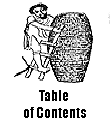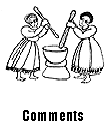
|
The Tasteby: Birabiro The sign says "Mojo Injera Company". I am to meet its president. I try to count the number of floors this building has, and I lose interest after 20. Perhaps "Mojo Injera" is just one of the tenants here. As I step through the main entrance and into the sleek lobby, I stare up at the huge company logo. The designer of the logo has morphed a few specks of Teff grain into what has become the global symbol for Injera, a dimpled circle. The size of the logo does not compromise space for any other corporate entity. The president is a snappily dressed man. He has the jowls of someone used to indulging his appetite. He also has the calculating eyes of a hard-nosed businessman. "Let me begin by thanking you for this opportunity," I say, "but I must say that it was some of your help wanted ads that piqued my interest." "Oh, yes", he says, "we are a very big business, and we need a lot of people." "Perhaps I should make clear that it was more, ah, the types of positions you are advertising, than the quantity, which has made me curious. I hope you know that I specialize in science and technology stories." The president nods with Confucian understanding. "I see. Why don't I give you a tour of this facility first, and in the process, we will see if we can answer any questions you may have." "Very well", I say, and take out my digital recorder from my coat pocket. This is going to be a visual record. I detach the camera from the recorder tablet, pull out the tripods from my other coat pocket, and I am ready in two minutes flat. The camera will adjust for contrast, brightness and focus and give me transmission quality motion pictures. "First of all, how come an Injera company is so big?" I ask, knowing how amateurish my question sounds. The size and opulence of the building has impressed me. "Well, we are a global company now. The eighties and nineties of the twentieth century has exiled many, many Ethiopians. They have spread out all over the globe - America, Europe, Australia, the Middle East, the Far East. And where they have gone they have taken their taste and affinity for Injera with them, and they have been successful in transplanting that into the cultures they ended up in. So our customers today are not just Ethiopians or those of Ethiopian descent." "So, how much do you do in sales a year?" He smiles, and says, "Enough." He has the self-satisfied smirk of someone who knows he has something one up on you. Business info was not going to be forthcoming. I decide to stick to what I have originally come for. "What does your company need electronics engineers for?" I ask. "All in good time," he says, and takes me through a door marked "Marketing Research." "OK, what happens here is that we study what the customer wants in their Injera. The taste first of all, and then the optimum sizes, thicknesses, softness, tensile strength." "Tensile strength?" I ask. "Yes, we have found that the amount of resistance the Injera gives to the person trying to tear a piece of it might be a factor on whether they will be long term customers, or go to our competition." "You must be joking!" I say, incredulous. He does not miss a beat. "No. This is a serious business. We have tough competition. That is one of the metrics we have identified that can differentiate one company from another." "OK, what else," I say, with visions of weight lifting just to eat my Injera coming to mind. "We also look at soakability. We do not want the Injera to break apart just because of the sauce seeping into it. We also do not want the customer to end up with Injera that is only surface wetted." "What is that?" I ask, pointing to a room labeled "Visual Aesthetics Research." "Well, over there they study any feature of the Injera that makes it look attractive. We are talking color, dimpling, edge crispness - that sort of thing." "What do you mean by 'dimpling'?" "I mean the dimples - or the pitting, if you prefer - that you see on any Injera. We look at dimple density, things like how many dimples per square centimeter. We also investigate what the average dimple size should be - we try to establish a average and some acceptable high and low dimple size limits. Then there is the issue of dimple morphology - you would assume that all dimples are perfect circles, but that is not necessarily the case. You would be surprised how tough it is to quantify all that." We are heading to a room labeled "Suspension Analysis." "The stuff we do here is very important," he says. "Here we study what the average size of the flour particle should be, the optimum delay between mixing and pouring, the viscosity of the mix. Ultimately it helps us to quantify the thickness of the mix and the best time and method of pouring." "Don't flour mills give you fairly standard powder sizes, and what is wrong with those?" I ask. "Well, we want to create the best solution of water and flour minimizing mixing energy and time. The best solution is one that gives us the characteristics we have been talking about." "Oh, yes - the dimples and all that." "Yes." He has a tone of displeasure. I suspect he senses a note of sarcasm in my voice. We look in the thermal sciences room, where the heating temperature and moisture drive-off rates are being studied. The chemistry lab is filled with people earnestly trying to break down the constituent chemicals of injera. The geneticists are trying to splice genes between grain species. As we go room to room, it is obvious to me that this company is investing a lot of resources in trying to understand Injera. I ask my question. "All right. This is all very impressive. But it is also very expensive, why are you spending so much money on understanding Injera when in fact you already have a superior product out there. Many people love your Injera over everybody else's." "Well, I have only shown you one section. Let me show you something here." He is leading me to another door. He stops in front of a table that has a black cloth draped over a boxy item. As he grabs hold of a corner of the cloth, I can tell a proud gleam in his eyes. He pulls the cloth back to reveal a box about half the size of a microwave oven. "This is why we have been hiring programmers and finite element analysts, among others." The pride in his voice is unmistakeable. "We call this the Mojo Gojjo. It is going to be the first fully automatic Injera machine. And it is designed for individual families." "What do you mean by fully automatic?" "If you have one of those, all you need to do is buy our premixed packets of flour, and pour it into this machine here, pour water in this container here, and two minutes later you start getting the perfect Injera." I slowly start to understand what his company is about to do. Once Mojo starts selling these machines, they are no longer manufacturers of perishable goods. These machines, once patented, will give them much higher profit margins - almost all of it exclusively theirs. They will not get ruined on the shelf. Selling proprietary mixes as opposed to Injera already made gives them long shelf life. That, in turn, eases logistics and allows them to better satisfy demand as it actually is, as opposed to anticipating it. They can also customize the mixes for the market. Or sell mixes that are nutritionally or genetically enhanced. He shows me a flour packet and points out some white and black stripes and dots on its bottom. "We anticipate that some of our non-standard mixes may require slight changes in preparation, and hence in the way the machine makes Injera. These are instructions for the machine to change its program accordingly." I do not understand. "Give me an example." "Well, if we added, say, ground soy, to our standard grain mix, then the oil from the soybean will affect how well the mixture can be suspended in water. So we have to tell the machine to increase the amount of water used, to agitate and stir for a longer period of time, and perhaps to remove from the hot plate later or sooner - depending on the circumstance." I stand in awe in front of that little machine. The Gojjo is engineered to embody everything Mojo has learned about the perfect Injera. Its soury taste. Its soft touch. Its thin suppleness. Its innumerable little pits and dimples, perfectly sized and distributed. Its neutral whitish-gray color. "Before I leave", I ask the President, "Can you tell me what was in the VI room?" He hesitates. After a moment, he says, "Will you promise to keep this to yourself?" "Of, course!!" "That room is where we are formulating what we call virtual injera." "Please explain. I can understand how you can have virtual sound or images. But food is tangible, and must be in its physical form if it is to be of any use." "Let me start by taking the example of color. Any color is ultimately the combination of the three primary colors. As long as you can specify the realtive quantity of one with another you can save or transmit color in any communication medium. We believe that ultimately taste will also be captured in the same fashion. What we do in that room is then to try and break down the taste of injera into its most basic constituent elements. Once we become the first to do so, we can legitimately claim intellectual property rights on its taste." I look at him skeptically. "How can you 'own' taste?" He laughs. "Look, in this day and age, the world does not eat Injera – or any other type of food for that matter – because it is the only thing available, or because it is a necessity. There is enough nourishment to go around. But people pay for the taste of something different. We will be moving into an age where even our brand new Gojjo will become irrelevant, and every home will have a universal food dispenser. You just select what you want from the digitally stored 'recipe' list in the machine's memory, and the machine will prepare it for you. If it is not listed in your machine, you will be able to download the digital recipe from the internet." "That still does not tell me how you can profit from it" "Think of it as a per use fee. Right now, for example, you can pay to use something, or to experience something over the internet – let's say, music, or running an application, or accessing a private database. We think unique recipes will be like that in the near future. A chef can have his masterpiece immortalized in digital form, and sell it over the net. I will grant you that we are not there yet, but we are convinced it is going to happen, and not in the too distant future either." As I bid him farewell, I cannot help but envision my own injera experiences. The Teff market at Mojo. Old Man Sahelu's donkeys and the trip to the mill. Warm Teff powder gently falling into hands. "My" first engocha, qatenya, aflenya. My friend Negash and our recipe disputes. I suddenly realize the President has not even uttered the word "Teff". It seems the further along I ago in years from my youth, and in physical distance from the land of my birth, the further Injera gets from Teff and the human touch. It is well on its way to being distilled into its basic essence. Its look. And its taste. |

|

|

|

|

|
| © Copyright SELEDA Ethiopia, June 2001. All Rights Reserved. |